The Arkansas Valley National Bank Of Broken Arrow
The Arkansas Valley National Bank Of Broken Arrow in Oklahoma printed $53,500 dollars worth of national currency. A production number that low doesn’t save room for many survivors. Currency from this bank will be rare. This national bank opened in 1905 and stopped printing money in 1909, which equals a 5 year printing period. That is obviously a very short period of time. During its life, The Arkansas Valley National Bank Of Broken Arrow issued 7 different types and denominations of national currency. We have examples of the types listed below. Your bank note should look similar. Just the bank name will be different. For the record, The Arkansas Valley National Bank Of Broken Arrow was located in Tulsa County. It was assigned charter number 7600.
We buy all national currency. Please call or email us for a quote. Sales@AntiqueMoney.com
The Arkansas Valley National Bank Of Broken Arrow in Oklahoma printed 800 sheets of $5 1902 territorial red seal national bank notes. A print run under 1,000 will get the attention of most people. Combine that with a territorial and you have a real winner. 1902 red seals have always been a collector favorite. Territorial bank notes have always been popular. When you combine those two factors the result can be a very valuable bank note. We are of course specifically looking at the five dollar denomination. Most $5 red seals are known to exist from Fairbanks, Alaska, thanks to a hoard discovery in the 1960s. There are also about a dozen $5 territorial red seals known to exist from Oklahoma. The design is exactly like any other third charter bank note. Ben Harrison is on the left hand side of the bill. There is a red four digit charter number and red seal. The charter number is printed around the border of the bill several times.
1902 $5 Red Seal Territorial National Bank Note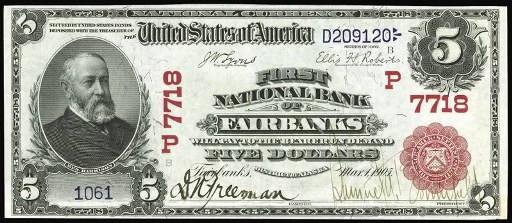
The Arkansas Valley National Bank Of Broken Arrow printed 560 sheets of $10 1902 territorial red seal national bank notes. A print run under 1,000 will get the attention of most people. Combine that with a territorial and you have a real winner. This denomination and type was the most prolifically issued territorial note. Some can be quite rare. There is a hierarchy in terms of rarity. Red seals from Hawaii are the absolute rarest. In fact, none from Hawaii are currently known to exist. Ten dollar red seals from Porto Rico are also extremely rare, as are red seals from Alaska. The average collector is most likely to encounter red seals from Arizona, New Mexico, and Oklahoma. There were far more territorial banks in Oklahoma during the red seal period than any other state, so notes from Oklahoma are the most common. However, most all red seals should be worth more than $10,000, and sometimes considerably more. William McKinley is pictured on the left hand side of each bill. The number under McKinley is the bank serial number. If that number is #1, then you can expect an additional premium on the value.
1902 $10 Red Seal Territorial National Bank Note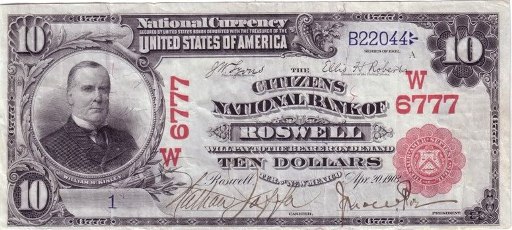
The Arkansas Valley National Bank Of Broken Arrow also printed 560 sheets of $20 1902 territorial red seal national bank notes. That of course equals the number of sheets printed for the ten dollar denomination. A total of 259 national banks in the country issued $20 territorial red seals. There are currently only about 30 of them known to exist, and that total includes all national banks. That survival rate is really poor. That means that these notes are rare and valuable. They were usually printed in small quantities and very few new ones are found these days. High grade examples are scarce as are notes printed by banks not located in Oklahoma.
1902 $20 Red Seal Territorial National Bank Note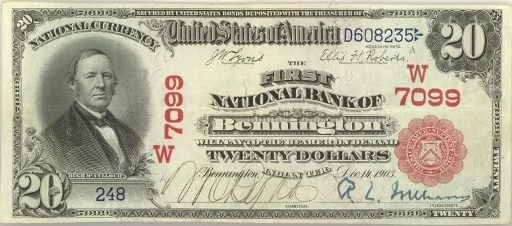
The Arkansas Valley National Bank Of Broken Arrow also printed 150 sheets of $5 1902 red seal national bank notes. All red seals are very rare. But that sheet output is extremely low. We would love to see a picture of what you have. Five dollar red seals are typically a little bit rarer than some higher denominations. That rarity is typically just a result of small issuances. Most national banks preferred to issue $10 and $20 1902 red seals. Each one of these five dollar bank notes has a portrait of Ben Harrison on the left hand side of the bill. Most people are quick to notice the cursive charter date with a year between 1902 and 1908 written on it. That date will never affect the value.
1902 $5 Red Seal National Bank Note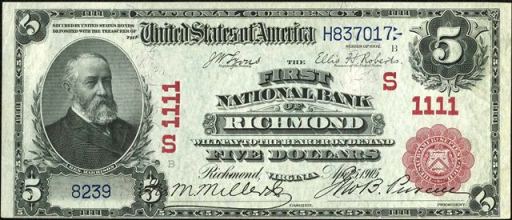
The Arkansas Valley National Bank Of Broken Arrow also printed 116 sheets of $10 1902 red seal national bank notes. All red seals are very rare. But that sheet output is extremely low. We would love to see a picture of what you have. Collectors love ten dollar 1902 red seals. They usually represent the rarest bank notes printed by any national bank. Don’t let the term “series of 1902” confuse you. These were actually printed for about six years between 1902 and 1908. That is obviously a very short issue period which means that many red seals are quite rare. Each note has a portrait of William McKinley. Be sure to check the number under McKinley. If it is #1 then you are dealing with a note from the first sheet of bank notes issued. Number one bank notes are worth even more money than the already rare red seals.
1902 $10 Red Seal National Bank Note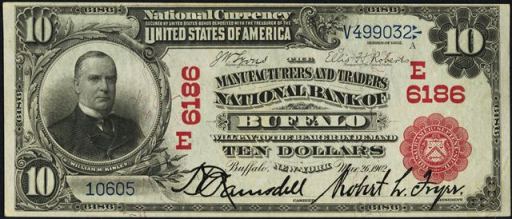
The Arkansas Valley National Bank Of Broken Arrow also printed 116 sheets of $20 1902 red seal national bank notes. Twenty dollar red seal bank notes have poor survival rates. They don’t command premiums compared to the ten dollar denomination, but they are definitely rarer. All 1902 red seals were printed on four note sheets. There were three ten dollar bills and one twenty dollar bill per sheet. The 1902 $20 notes have a portrait of Hugh McCulloch on them. The charter number and seal are both printed in red ink. The serial numbers have a slight blue tint to them. The charter number is printed around the border of the note several times. The bank’s title is right in the middle of the note and the state of issue is printed just below the title. Remember that all national bank notes are valued based on their condition and rarity. The same rule applies to 1902 $20 red seals.
1902 $20 Red Seal National Bank Note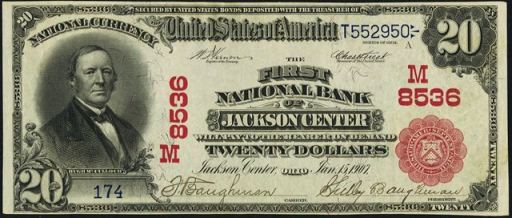
The Arkansas Valley National Bank Of Broken Arrow also printed 35 sheets of $5 1902 blue seal national bank notes. In the scheme of things that is a really tiny printing number. You are likely dealing with a true rarity. Ben Harrison is on the front of all 1902 $5 blue seal bank notes. This happens to be the smallest denomination issued for the 1902 series. Each note is complete with a blue seal and blue charter number. Despite saying series of 1902, these were actually issued by national banks between 1908 and 1928. There are two different types of blue seals. The first type is called a date back and it has “1902-1908” written on the back of the bill. The other type is called a plain back; it does not have the date stamps on the back of the bill. The values for these notes range widely based on condition and the bank of issue.
1902 $5 Blue Seal National Bank Note



